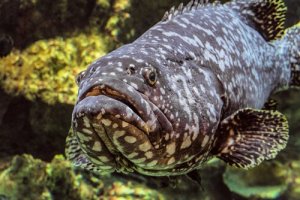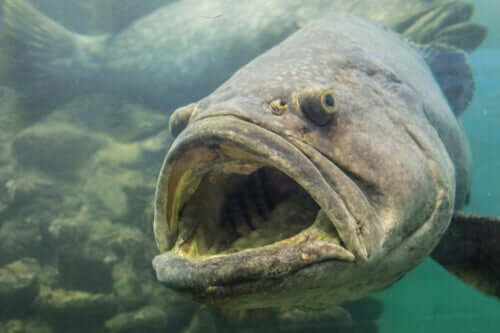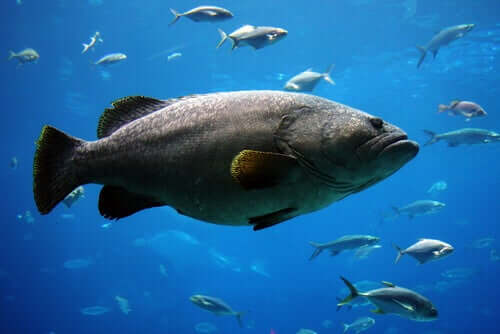The Atlantic Goliath Grouper: Characteristics and Habitat


Written and verified by the biologist Paloma de los Milagros
The Atlantic goliath grouper, whose scientific name is Epinephelus itajara, is a grouper species characterized by its large dimensions. The majority of the Atlantic goliath grouper population is located along the coasts of the American coast. However, this fish has also been spotted in northeast Africa.
The Atlantic goliath grouper goes by several other names, including jewfish and itajara and many local nicknames. Historically, its size has made it popular among fishers and merchants to the point that it became the object of recreational competitions. Furthermore, its meat stands out for its nutritional value and renowned taste, similar to that of the common grouper.
Morphology and behavior of the Atlantic goliath grouper
This animal is one of the largest fish in the Atlantic ocean. It can come to measure up to 8.2 feet and weigh up to 680 pounds. It possesses a robust and elongated body, with a wide head in comparison to its small eyes. Its rounded pectoral fins and tail fin are larger than the pelvic and dorsal fins. What’s more, the base of the dorsal fin stands out as being covered with scales and thick skin.
Its yellowish, greyish or olive-toned coloring with small spots help the Atlantic goliath grouper blend into its environment. Normally, these tones become more subdued as the fish grows in size and age. At the same time, younger specimens may present a reddish, linear pattern.

This fish’s diet consists basically of crustaceans, fish, octopi and even an occasional young sea turtle. To eat, it has three to five rows of teeth on its lower jaw. These teeth, particularly the incisors, have a characteristically limited development. This feature helps distinguish this species from other large groupers.
In general, the African goliath grouper captures its prey by ambush. It tends to hide among the reefs until a viable prey passes by. At the same time, this species stands out for hiding from its predators. These include the Atlantic mackerel, moray eels, the sandbar shark and the great hammerhead shark.
Reproduction
When it comes to reproduction, the Atlantic goliath grouper is quite particular in that it is a protogynous hermaphrodite. This means that it first matures sexually as a female and then, with age, turns into a male.
During its time as a female, the fish lays eggs, and during its time as a male, it produces sperm. After fertilization, these eggs scatter with the water’s current. This characteristic that deems this species a pelagic fish, just like the blue parrotfish.

Habitat and conservation state
The majority of these gigantic fish live in deep waters, near rocky areas with coral and mud. As they live relatively close to the coastline, this may make their capture easier. However, they tend to hide in caves where they take on a very territorial and solitary attitude.
Their geographic location is, for the most part, the American coast from Florida down to southern Brasil. This includes the Caribbean Sea. However, a number of these fish also live along the Pacific coast from California down to Peru. It’s also worth pointing out that there are also Atlantic goliath groupers living along the African coast from Senegal to the Congo. On rare occasions, they have been spotted around the Canary Islands.
The enormous size of this fish, along with its great gastronomic value, make it a much sought-after catch for fishermen. However, its slow growth and low reproduction rate make it one of the most susceptible species to extinction.
In fact, the International Union for Conservation of Nature (UICN) considers the African goliath grouper to be vulnerable. This is in light of the fact that its population has decreased by 80% in the last 10 years.
The Atlantic goliath grouper, whose scientific name is Epinephelus itajara, is a grouper species characterized by its large dimensions. The majority of the Atlantic goliath grouper population is located along the coasts of the American coast. However, this fish has also been spotted in northeast Africa.
The Atlantic goliath grouper goes by several other names, including jewfish and itajara and many local nicknames. Historically, its size has made it popular among fishers and merchants to the point that it became the object of recreational competitions. Furthermore, its meat stands out for its nutritional value and renowned taste, similar to that of the common grouper.
Morphology and behavior of the Atlantic goliath grouper
This animal is one of the largest fish in the Atlantic ocean. It can come to measure up to 8.2 feet and weigh up to 680 pounds. It possesses a robust and elongated body, with a wide head in comparison to its small eyes. Its rounded pectoral fins and tail fin are larger than the pelvic and dorsal fins. What’s more, the base of the dorsal fin stands out as being covered with scales and thick skin.
Its yellowish, greyish or olive-toned coloring with small spots help the Atlantic goliath grouper blend into its environment. Normally, these tones become more subdued as the fish grows in size and age. At the same time, younger specimens may present a reddish, linear pattern.

This fish’s diet consists basically of crustaceans, fish, octopi and even an occasional young sea turtle. To eat, it has three to five rows of teeth on its lower jaw. These teeth, particularly the incisors, have a characteristically limited development. This feature helps distinguish this species from other large groupers.
In general, the African goliath grouper captures its prey by ambush. It tends to hide among the reefs until a viable prey passes by. At the same time, this species stands out for hiding from its predators. These include the Atlantic mackerel, moray eels, the sandbar shark and the great hammerhead shark.
Reproduction
When it comes to reproduction, the Atlantic goliath grouper is quite particular in that it is a protogynous hermaphrodite. This means that it first matures sexually as a female and then, with age, turns into a male.
During its time as a female, the fish lays eggs, and during its time as a male, it produces sperm. After fertilization, these eggs scatter with the water’s current. This characteristic that deems this species a pelagic fish, just like the blue parrotfish.

Habitat and conservation state
The majority of these gigantic fish live in deep waters, near rocky areas with coral and mud. As they live relatively close to the coastline, this may make their capture easier. However, they tend to hide in caves where they take on a very territorial and solitary attitude.
Their geographic location is, for the most part, the American coast from Florida down to southern Brasil. This includes the Caribbean Sea. However, a number of these fish also live along the Pacific coast from California down to Peru. It’s also worth pointing out that there are also Atlantic goliath groupers living along the African coast from Senegal to the Congo. On rare occasions, they have been spotted around the Canary Islands.
The enormous size of this fish, along with its great gastronomic value, make it a much sought-after catch for fishermen. However, its slow growth and low reproduction rate make it one of the most susceptible species to extinction.
In fact, the International Union for Conservation of Nature (UICN) considers the African goliath grouper to be vulnerable. This is in light of the fact that its population has decreased by 80% in the last 10 years.
All cited sources were thoroughly reviewed by our team to ensure their quality, reliability, currency, and validity. The bibliography of this article was considered reliable and of academic or scientific accuracy.
- Robins, R.H. (S.f). Florida Museum. Epinephelus itajara. Recuperado de https://www.floridamuseum.ufl.edu/discover-fish/species-profiles/epinephelus-itajara/
- Ministerio de Agricultura y Ganadería de Ecuador. El pez guato es uno de los más grandes de la costa del Pacífico. (S.f). Recuperado de https://www.agricultura.gob.ec/el-pez-guato-es-uno-de-los-mas-grandes-de-la-costa-del-pacifico/
This text is provided for informational purposes only and does not replace consultation with a professional. If in doubt, consult your specialist.








